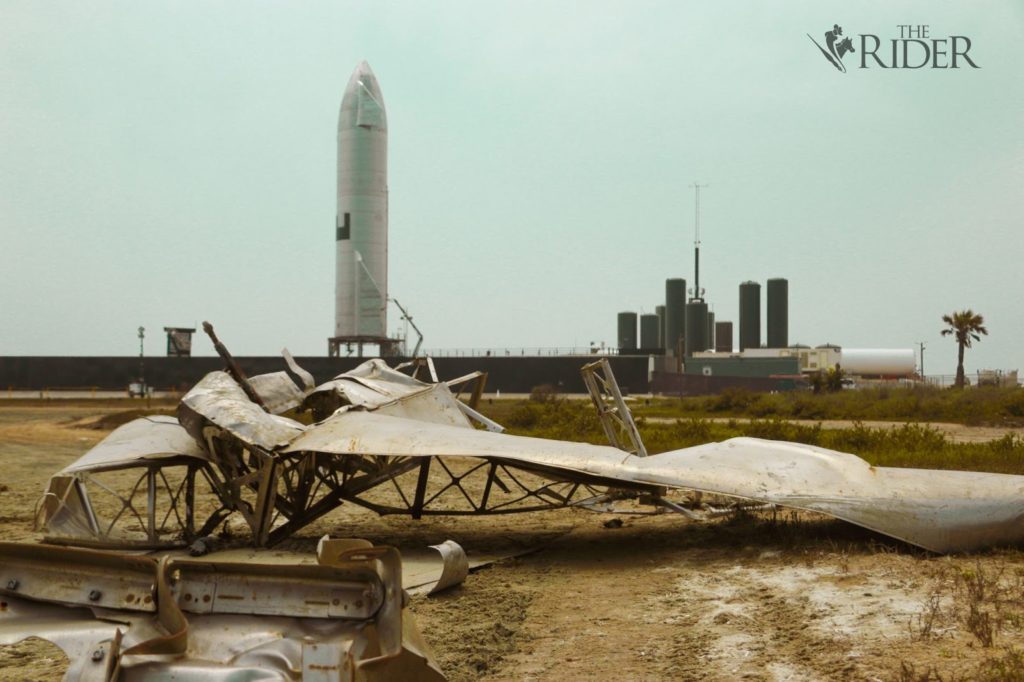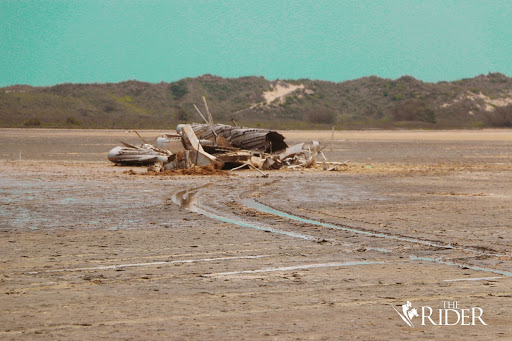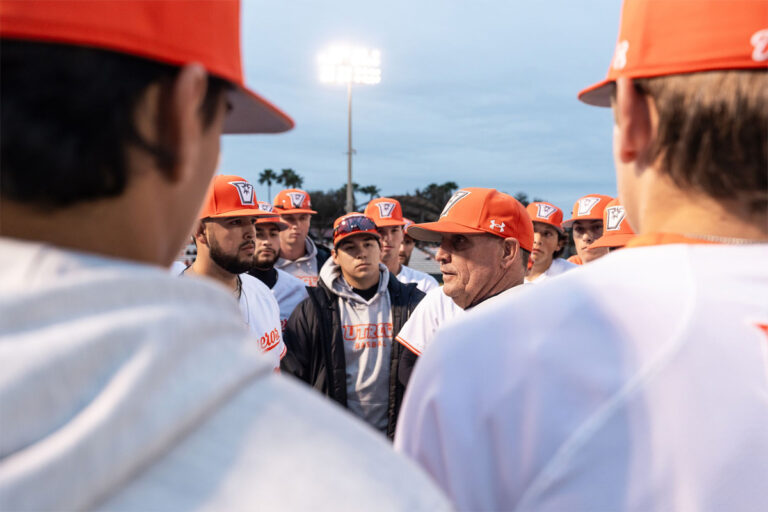
Luis Martinez Santillano/The Rider Photos
Alejandra Yañez | THE RIDER
Over two weeks after the failed launch of Starship SN11, debris from its explosion is still scattered across the Boca Chica site and surrounding areas, leaving environmentalists concerned about future “pollutants” from SpaceX’s larger rockets.
It is estimated that debris traveled 1,000 meters into state and federally managed land, according to the U.S. Fish and Wildlife Service (USFWS).
In a statement sent to The Rider Thursday morning, the Texas Parks and Wildlife Department wrote “SpaceX worked closely with USFWS and other agencies in retrieval of explosion debris to minimize impacts to wildlife and sensitive habitats.”
An email from USFWS last Thursday stated that while SpaceX is taking the lead on recovering debris, a team consisting of the federal agency, Texas Parks and Wildlife Department, National Park Service and Texas Historical Commission provide on-the-ground guidance to minimize further impacts and reduce long-term damages to natural resources.
The environmental organizations worked collaboratively to develop a “debris retrieval strategy” specific to the SN11 anomaly and the site conditions.
“The strategy aimed at minimizing further impacts and reducing long term damages,” Aubry Buzek,
public affairs specialist-Texas for the U.S. Fish and Wildlife Service, wrote in the email.
However, despite the team’s efforts, fallen debris lodged into different types of habitats and soils, Buzek wrote.
On Wednesday, The Rider visited Boca Chica and found giant metal scraps lodged into the land and tidal flats off State Highway 4. Tractors were seen piling up the debris.

“Access in the way of constant ingress/egress to retrieve debris materials created disturbance and unintentional paths across the landscape,” Buzek wrote in the email.
The environmental agency said recovery of the debris is ongoing.
“We are continuing to evaluate our options and are working closely with SpaceX to make the best decisions for the habitat,” the USFWS said.
However, some of the debris is still visible across the land and tidal flats off State Highway 4.
Shortly after the explosion of SN11, SpaceX created a hotline for the public to call and report any debris found. The company also advised the public not to handle any of the materials.
The Rider contacted the SpaceX Media Relations department for comment, but as of press time Friday it had not received a response.
Cameron County Judge Eddie Treviño Jr., who was contacted earlier in the week for an interview, also had not returned calls as of press time Friday.
The explosion and debris from SN11 left several community members concerned, including Friends of the Wildlife Corridor President Jim Chapman, who wonders how the environment will fare once the SpaceX test flights become more heavily powered.
“What SpaceX is now proposing to launch at Boca Chica is the Starship on top of the Super Heavy booster,” Chapman said. “So, the explosions we’ve seen so far are in the Starship prototype, which has three Raptor Engines, which is the engine that SpaceX developed, and the fuel for those three engines. Well, Super Heavy will have 30 Raptor Engines. So, what you’re looking at is something 10 times the size. The Starship SN11 alone, when it blew up, debris got all the way to South Padre Island. So, what will Super Heavy do if it blows up?”
The Rider asked if he believes SpaceX is being properly regulated concerning the environment.
“Well, SpaceX answers to the [Federal Aviation Administration] and that’s really one of the problems because the FAA is not an environmental agency,” Chapman replied. “Their mission is aviation and space and so, they promote American space activity.
“So, unfortunately, you have the agency that has to oversee their activities, including their requirements to try and protect the environment. That agency, that’s really not what they do, so I think that’s unfortunate.”
He said natural resource agencies, such as Texas Parks and Wildlife, USFWS and the General Land Office, all provide input to the FAA on protection activities for the environment.
However, the FAA has the final say in deciding what SpaceX has to do to protect the environment.
“So, on that front, there’s two issues: The FAA determines when they listen to what the natural resource agencies are telling them and at the end of the day, the FAA tells SpaceX what they have to do in terms of environmental protection,” Chapman said. “The second part of that is that the FAA then has to enforce those regulations.”
Last July, the Friends of the Wildlife Corridor wrote to the FAA requesting a new environmental impact statement due to its concerns about the enforcement of these regulations but did not receive a response.
“The FAA decided to do an environmental assessment instead of an environmental impact statement, and they had a comment period for public comments,” Chapman said.
The time frame to submit comments was from December 2020 to January 22, 2021.
Chapman said his organization and other environmental groups submitted scoping comments, asking the FAA to look at all the impacts that SpaceX causes, including construction, testing, launching, explosions and fires.
Scoping refers to federal agencies considering the public’s comments to determine the scope of issues that should be addressed.
Friends of the Wildlife Corridor also asked the FAA to review the company’s impact on vegetation, wetlands and wildlife in the surrounding area. The organization also requested that the Federal Energy Regulatory Commission conduct a thorough launch failure analysis of SpaceX.
Last month, the FAA released the Scoping Summary Report for the Draft Environmental Assessment for the SpaceX Starship/Super Heavy Launch Vehicle Program at the SpaceX Boca Chica Launch Site.
The report states that the FAA is evaluating SpaceX’s proposal to operate the Starship/Super Heavy launch vehicle at its Boca Chica Launch site.
“SpaceX must obtain an experimental permit and/or a vehicle operator license from the FAA to operate the Starship/Super Heavy launch vehicle,” the report states. “Issuing an experimental permit or a vehicle operator license is considered a major Federal action under the National Environmental Policy Act (NEPA).”
The report also acknowledged the public’s scoping comments, including concerns about potential impacts on protected species and habitat, the level of environmental review (i.e., the appropriateness of an EA versus an EIS), potential impacts on airspace, potential impacts on land of cultural importance, safety of launch operations given the proximity to nearby liquified natural gas facilities and degradation of the environment due to test and launch operations.
The Rider asked the FAA questions regarding the report, but as of press time Friday, the agency had not responded.
The FAA has not issued a new environmental assessment.

Luis Martinez Santillano/ The Rider Photos
Asked what his thoughts are on SpaceX choosing Boca Chica as a launch site, Chapman replied, “As a testing and development facility, they don’t need to be there. You know, when you’re developing and testing brand-new rockets, that should be at some facility that’s far away from people, that’s not adjacent to wildlife refuge land and not adjacent to wetlands. So, my feeling is that the experimentation in testing should be done elsewhere.”
He said his message to Elon Musk, SpaceX CEO and founder, and the community is that what SpaceX is proposing has too many environmental impacts on Boca Chica wildlife.
The Texas Parks and Wildlife Department said SpaceX actively communicates and collaborates with the state agency, as well as USFWS, given its role as the landowner and its overall responsibility to provide recommendations to protect fish and wildlife resources.
The long-term disturbance or impacts from the debris onsite are not known and are being carefully considered in collaboration with SpaceX and other responding parties, according to USFWS.





